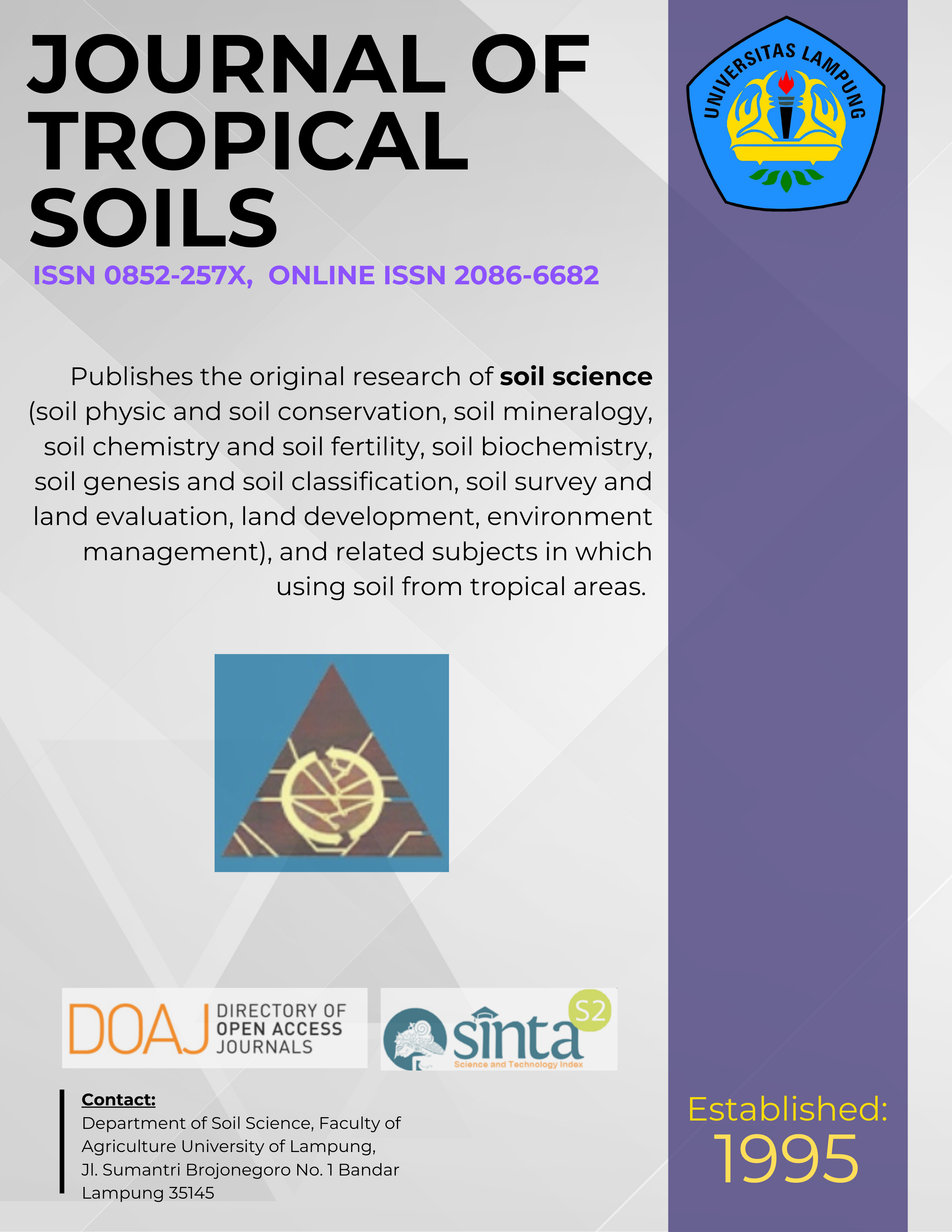Kelarutan Fosfat dan Ferro pada Tanah Sulfat Masam yang Diberi Bahan Organik Jerami Padi
Main Article Content
Abstract
Downloads
Article Details
Issue
Section
License for Authors
Authors who publish with this journal agree to the following terms:
- Authors retain copyright and grant the journal right of first publication with the work simultaneously licensed under a Creative Commons Attribution License that allows others to share the work with an acknowledgement of the work's authorship and initial publication in this journal.
- Authors are able to enter into separate, additional contractual arrangements for the non-exclusive distribution of the journal's published version of the work (e.g., post it to an institutional repository or publish it in a book), with an acknowledgement of its initial publication in this journal.
- Authors are permitted and encouraged to post their work online (e.g., in institutional repositories or on their website) prior to and during the submission process, as it can lead to productive exchanges, as well as earlier and greater citation of published work (See The Effect of Open Access).
License for Regular Users
Other regular users who want to cite, distribute, remix, tweak, and build upon author’s works, even for commercial purposes, should acknowledge the work’s authorship and initial publication in this journal, licensed under a Creative Commons Attribution License.
How to Cite
References
Barker, A.V. and D. J. Pilbeam. 2007. Hand Book of Plant Nutrition. CRC Press. New York. 612 p.
Barrow, N. J. 1989. Relating chemical process to management system. In: Phosphorus Requirement for Sustainable Agriculture in Asia and Oceania. IRRI. Los Baños, Laguna, Philippines, pp. 199-210.
Brady, N. C., and R. R. Weil. 2002. The Nature and Properties of Soils. 13th Edition. Upper Saddle River, New Jersey. 960 p.
Fahmi, A., A. Susilawati, dan A. Jumberi. 2006. Dinamika unsur besi, sulfat dan posfor serta hasil padi akibat pengolahan tanah, saluran kemalir dan pupuk organik di lahan sulfat masam. J. Tanah Trop. 12(1): 11-19.
Huang, P. M., and A. Violente. 1997. Pengaruh asam organik terhadap kristalisasi dan sifat permukaan produk pengendapan aluminium. Dalam: P. M. Huang, and M. Schnitzer. (Eds). Interaksi Mineral Tanah dengan Organik Alami dan Mikroba. Gadjah Mada University Press. Jogjakarta, pp. 242- 316.
Kirk, G. J. D., Y. T. Ren, and F. A. Choudhury. 1989. Phosphorus chemistry in relation to water regime. . In: Phosphorus Requirement for Sustainable Agriculture in Asia and Oceania. IRRI. Los Baños, Laguna, The Philippines, pp. 211-224.
Kongchum, M. 2005. Effect of Plant Residue and Water Management Practices on Soil Redox Chemistry, Methane Emission and Rice Productivity. A Desertation. Graduate Faculty of the Louisiana State University. USA. 201 p.
Kyuma, K. 2004. Paddy Soil Science. Kyoto University Press. Kyoto, Japan. 279 p.
Neue, H. U., and Z. Z. Lin. 1989. Chemistry of adverse flooded soils. In: Phosphorus Requirement for Sustainable Agriculture in Asia and Oceania. IRRI. Los Baños, Laguna, The Philippines, pp. 225- 242.
Purnomo, E., A. Mursyid, M. Syarwani, A. Jumberi, Y. Hashidoko, T. Hasegawa, S. Honma, and M. Osaki. 2005. Phosphorus solubilizing microorganisms in the rhizosphere of local rice verities grown without fertilizer on acid sulphate soils. Soil Sci. Plant Nutr. 51(5): 679-681.
Reddy, K. R., dan R. D. Delaune. 2008. The Biogeochemistry of Wetlands: Science and applications. CRC Press. New York, USA. 779 p.
Stevenson, F. J. 1994. Humus Chemistry. Genesis, Composition, Reaction. John Wiley and Son Inc. New York. USA. 496 p.
Sudhalakhsmi, C., V. Velu and T.M. Thiyagarajan. 2007. Redox Potential in the Rhizosphere Soil of Rice Hybrid as Mediated by Crop Management Options. Res. J. Agric. Biol. Sci. 3(4): 299-301.
Tan, K. H. 1997. Degradasi mineral tanah oleh asam organik. Dalam: P. M. Huang, and M. Schnitzer. (Eds). Interaksi Mineral Tanah dengan Organik Alami dan Mikroba. Gadjah Mada University Press. Jogjakarta, pp. 1-40.
Yoshida, T. 1978. Microbial metabolism of rice soils. In: Soils and Rice. IRRI. Los Baños, Laguna, The Philippines, pp. 445- 464.

